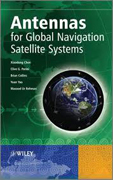
Antennas for global navigation satellite systems
Chen, Xiaodong
Parini, Clive G.
Collins, Brian
Yao, Yuan
This book addresses the fundamentals and practical implementations of antennas for Global Navigation Satellite Systems (GNSS)In this book, the authors discuss the various aspects of GNSS antennas, including fundamentals of GNSS, design approaches for the GNSS terminal and satellite antennas, performance enhancement techniques and effects of user’s presence and surrounding environment on these antennas. In addition, the book will provide the reader with an insight into the most important aspects of the GNSS antenna technology and lay the foundations for future advancements. It also includes a number of real case studies describing the ways in which antenna design can be adapted to conform to the design constraints of practical user devices, and also the managementof potential adverse interactions between the antenna and its platform.Key Features:Covers the fundamentals and practical implementations of antennas for Global Navigation Satellite Systems (GNSS)Describes technological advancements for GPS, Glonass, Galileo and CompassAims to address future issues such as multipath interference, in building operation, RF interference in mobileIncludes a number of real case studies to illustrate practical implementation of GNSSThis book will be an invaluable guide for antenna designers, system engineers, researchers for GNSS systems and postgraduate students (antennas, satellite communication technology). R&D engineers in mobile handset manufacturers, spectrum engineers will also find this book of interest. INDICE: Preface ix1 Fundamentals of GNSS 11.1 History of GNSS 11.2 Basic Principles of GNSS 21.2.1 Time-Based Radio Navigation 21.2.2 A 3D Time-Based Navigation System 51.3 Operation of GPS 81.4 Applications Including DifferentialGPS 15References 182 Fundamental Considerations for GNSS Antennas 212.1 GNSS Radio Wave Propagation 212.1.1 Plane Waves and Polarisation 212.1.2 GNSS RadioWave Propagation and Effects 232.1.3 Why CP Waves in GNSS? 262.2 Antenna Design Fundamentals 262.2.1 Antenna Fundamental Parameters 262.2.2 LP Antenna Design and Example 292.3 CP Antenna Design 312.3.1 CP Antenna Fundamentals and Types 312.3.2 Simple CP Antenna Design Example 352.3.3 Technical Challenges in Designing GNSS Antennas 36References 403 Satellite GNSS Antennas 413.1 Navigation Antenna Requirements 413.2 Types of Antenna Deployed 413.3 Special Considerations for Spacecraft Antenna Design 503.3.1 Passive Intermodulation Effects 503.3.2 Multipactor Effects 52References 524 Terminal GNSS Antennas 554.1 Microstrip Antenna for Terminal GNSS Application 554.1.1 Single-Feed Microstrip GNSSAntennas 554.1.2 Dual-Feed Microstrip GNSS Antennas 604.1.3 Design with Ceramic Substrate 644.2 Spiral and Helix GNSS Antennas 664.2.1 Helix Antennas 664.2.2 Spiral Antennas 714.3 Design of a PIFA for a GNSS Terminal Antenna 73References 795 Multimode and Advanced Terminal Antennas 815.1 Multiband Terminal Antennas 815.1.1 Multiband Microstrip GNSS Antennas 825.1.2 Multiband Helix Antennas for GNSS 885.2 Wideband CP Terminal Antennas 955.2.1 Wideband Microstrip Antenna Array 955.2.2 High-Performance Universal GNSS Antenna Based on Spiral Mode Microstrip Antenna Technology 965.2.3 Wideband CP Hybrid Dielectric Resonator Antenna 965.2.4 Multi-Feed Microstrip Patch Antenna for Multimode GNSS 985.3 High-Precision GNSS Terminal Antennas 102References 1096 Terminal Antennas in Difficult Environments 1116.1 GNSS Antennas and Multipath Environment 1116.2 Statistical Modelling of Multipath Environment for GNSS Operation 1136.2.1 GPS Mean Effective Gain (MEGGPS) 1146.2.2 GPS Angle of Arrival Distribution (AoAGPS) 1166.2.3 GPS Coverage Efficiency (Εc) 1176.3 Open Field Test Procedure 1196.3.1 Measurement of GPS Mean Effective Gain 1196.3.2 Measurement of GPS Coverage Efficiency 1206.3.3 Measurement Set-Up 1206.4 Performance Assessment ofGNSS Mobile Terminal Antennas in Multipath Environment 1216.4.1 Design of Tested GPS Antennas 1226.4.2 Comparison Based on Simulated and Measured 3DRadiation Patterns 1276.4.3 Comparison Based on Measured 3D Radiation Patterns and Actual Field Tests 1296.5 Performance Dependence on GNSS Antenna Orientation 1336.6 Performance Enhancement of GNSS Mobile Terminal Antennas in Difficult Environments 1396.6.1 Assisted GPS 1406.6.2 GPS Signal Reradiation 1406.6.3 Beamforming 1416.6.4 Diversity Antennas 141References 1477 Human User Effects on GNSS Antennas 1497.1 Interaction of Human Body and GNSS Antennas 1497.2 Effects of Human Body on GNSS Mobile Terminal Antennas in Difficult Environments 1507.2.1 Design of Tested GPS Antennas 1517.2.2 Effects of Human Hand and Head Presence 1517.2.3 Effects of Complete Human Body Presence 166References 1798 MobileTerminal GNSS Antennas 1818.1 Introduction 1818.2 Antenna Specification Parameters 1838.2.1 Polarisation 1838.2.2 Radiation Patterns 1848.2.3 Impedance 1858.2.4 Gain/Efficiency 1868.2.5 Weight 1878.2.6 Bandwidth 1878.2.7 Phase Performance 1888.3 Classification of GNSS Terminals 1888.3.1 Geodetic Terminals 1888.3.2 Rover Terminals 1888.3.3 General Purpose Mobile Terminals 1898.4 Antenna Designs for Portable User Equipment 1908.4.1 Short Quadrifilar Helices 1908.4.2 Patch Antennas 1918.4.3 Smaller Antennas 1928.5 The Function of the Platform1928.5.1 Antenna Efficiency, Gain and Noise 1938.6 Comparing Antenna Performance on UEs 1948.6.1 Drive Testing 1948.6.2 Non-Antenna Aspects of Performance 1958.7 Practical Design 1978.7.1 Positioning the GNSS Antenna on the Application Platform 1978.7.2 Evaluating the Implementation 2008.8 Case Studies 2018.8.1 Measurement System 2018.8.2 Case 1: Modified PIFA on Face of Small PCB 2028.8.3 Case 2: Meandered Dipole Antenna on Top Edge of Small PCB 2038.8.4 Case 3:Modified PIFA above LCD Display on Smart-Phone-Size Device 2048.8.5 Case 4: Moving Modified PIFA from One to Adjacent Corner of PCB 2058.8.6 Cases 5 and 6:Effects of Platform Electronics Noise 2058.9 Summary 206References 206Appendix A Basic Principle of Decoding Information from a CDMA Signal 207Appendix B Antenna Phase Characteristics and Evaluation of Phase Centre Stability 211Index215
- ISBN: 978-1-119-99367-4
- Editorial: John Wiley & Sons
- Encuadernacion: Cartoné
- Páginas: 232
- Fecha Publicación: 23/03/2012
- Nº Volúmenes: 1
- Idioma: Inglés
